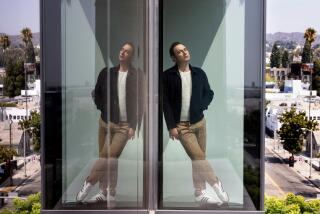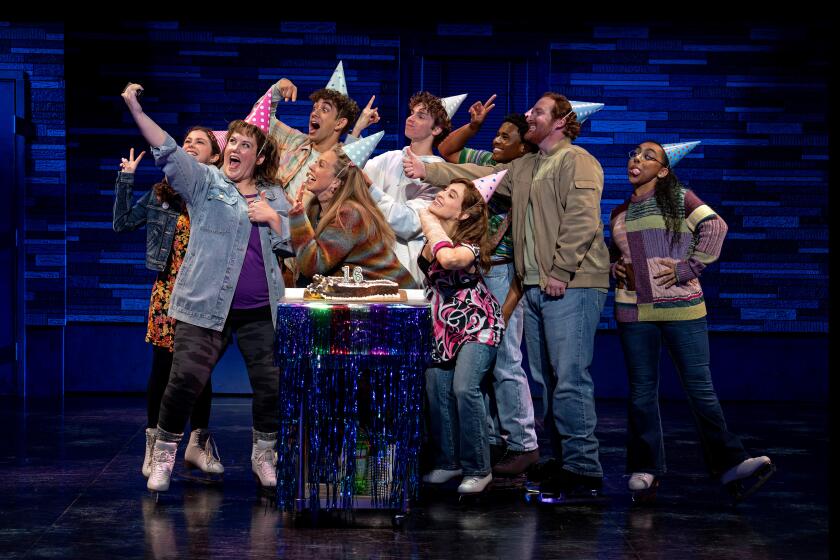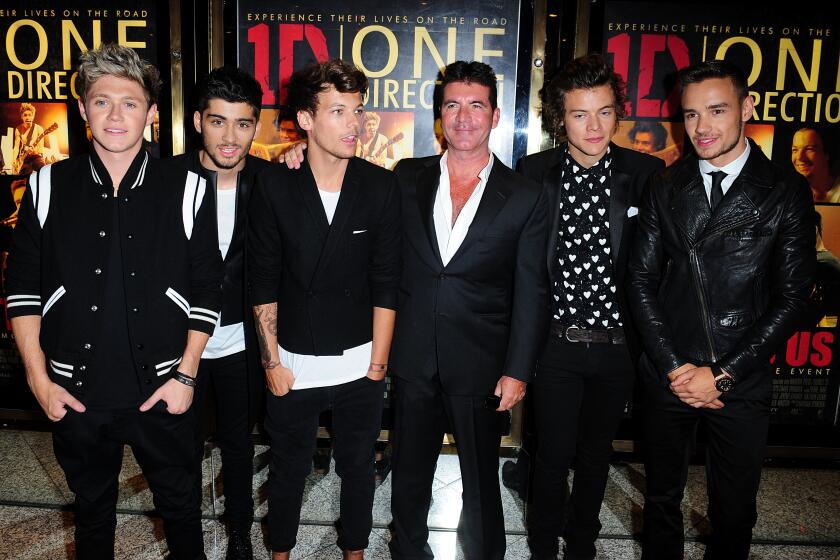A city garden of earthly delights
“Eden’s Edge: Fifteen L.A. Artists” is not a normal biennial survey exhibition. The show, handsomely installed at the UCLA Hammer Museum, wears its eccentricity on its sleeve.
It begins with history -- notably, a somewhat unexpected account -- and then follows a variety of paths that twist, turn and double back, asking you to leap to conclusions. All through the show a visitor finds himself thinking back on what he’s seen in earlier rooms. Retrospection anchors the experience of new art.
This show has art’s history on its mind. That’s unusual for Los Angeles.
Of the “Big Four” cities that dominate contemporary art, London feels the narrowest and most parochial, while Berlin seems the most freewheeling and internationally diverse. New York, paradoxically, looks the most obscure.
Partly that’s because the blinding glare of the marketplace, centered there, limits the focus to art as currency. And partly it’s because older, established artists are pretty much the only ones who can now afford to reside and work in Manhattan. Younger strivers orbit the island in the outer boroughs, forming a murky bridge-and-tunnel art world.
Los Angeles, by contrast, feels the most normal -- by which I mean densely layered, richly varied and large enough to elude any pretense to a comprehensive grasp. Surprises abound.
Of course, living here I’m biased on the normalcy claim. But one reason it seems conventional is that L.A.’s art histories remain sketchy, uncollected and largely unwritten. London, Berlin and New York all possess storied pasts that have been mined, enduringly enshrined in art museums and continuously reconsidered. Los Angeles -- not so much. In that way it’s like most every other city and thus is quite normal.
But this show repeatedly glances back over its shoulder. It’s the shock of the past.
Hammer chief curator Gary Garrels, who makes his debut at UCLA with this exhibition, chose 13 individual artists and one duo, ranging in age from over 70 to just over 30. Almost half were born in L.A., and two-thirds went to art school in Southern California.
Each artist has a separate gallery, and most are represented by work spanning several years (as much as a decade). With the exception of the late Jason Rhoades, who died last summer at 41, the rooms are installed roughly chronologically by the date of the artist’s birth. They’re a series of miniature one-person shows.
Rhoades had planned to unveil a new installation in the Hammer’s apse-shaped gallery. Instead, the pseudo-chapel is filled with an outlandish, whimsical chandelier, one of a series he began in 2003. Twelve abutted wagon wheels of varying sizes are suspended at an angle from the ceiling, suggesting everything from a clock’s internal mechanism to a corny fixture in a country western restaurant. On the floor nearby a fat cube of neatly folded towels is streaked with what appears to be dripped wax.
Like a New Orleans street party, or New Year’s Eve at Times Square, multicolored ribbons and neon signs hang from the wagon wheels. The glowing neon script, recalling barroom signage, records about four dozen slang terms for female genitalia. (Surfing the Internet, Rhoades had compiled a lexicon of more than 7,000 possible terms.) Look closely and phallic vegetables -- cucumbers, carrots and sweet potatoes -- are sprouting atop the wheel rims.
In Rhoades’ mad, extravagant light fixture, the West emerges as a blissful synthetic paradise, where original sin is intense, playful and inescapable. Eating fruit of the tree of knowledge was the first creative act of disobedience, which the best artists still accomplish.
Rhoades’ work comes at the end of a show that opens with Ken Price’s oozing, billowy, gorgeously erotic painted-ceramic forms. Price has been making brilliantly lewd ceramics for nearly 50 years, and these four are as fine as any works he’s made. When you get to Rhoades’ randy chandelier, Price’s “sex pots” have already been neatly embedded in your mind.
Garrel’s choice of a ceramic artist to open the show is inspired. Price’s work explores general social taboos around sexuality, which fits the two art-specific taboos of functionalism and refined craft that cling to ceramics. It sets a tone that resonates through the show.
The next room ups Price’s ante. It features five beautifully decorated paintings by Lari Pittman, whose queer aesthetic has been profoundly influential in the last two decades. His lush images of figures in elegant free-fall and bodily distress are lavishly adorned and chromatically pungent.
Their laborious, exquisitely fabricated handwork departs radically from the norm in the modern image-world, where mass-production by fabricators is the rule. Pittman once told me -- full disclosure: the artist is a friend -- that he thinks of this aspect of his work as the difference between couture and ready-to-wear. Anything but frivolous, the approach fuses pleasure with pain.
Price’s ceramics and Pittman’s wall decor classify art as a highly refined household object. In the third gallery, Jim Shaw’s small gouaches mounted on plywood panels take that notion for another spin, proposing themselves as fantastic cover illustrations for often lurid paperback books. (A suite of 12 pencil drawings also transform traditional corporate boardroom portraits of businessmen into monstrous distortions.) The strange suburban fantasia of all the imagery comes from Shaw’s dreams, which his art has been recording since the 1980s.
That internalized, secretive realm of fantasy now made public is key to Monica Majoli’s ethereal watercolors of male figures dressed in rubber fetish-gear, four of them life-size. Each haunting “Rubberman” is suspended within the space of the sheet of paper, its pale gray, green and violet layers of watercolor functioning like the recollection of a bruise. In an era marked by the brutal force of shock and awe, images of extreme surrender assume remarkable potency.
And so it goes throughout the exhibition. Sharon Ellis envisions nature as a spellbinding hallucination, a product of bedazzled imagination. Ginny Bishton builds organic, abstract collages from thousands of scissored plant and landscape snapshots, sacrificing specific photographic imagery in favor of suggestive tone and color.
Liz Craft’s large, goofy bronze sculptures of such 1960s icons as a hippie folk-singer and an “Easy Rider” biker wryly cast the moment immediately before her own 1970 birth in art’s most enduring -- and antiquated -- sculptural material. A historical period identified with liberation has the clumsy weight of an inescapable curse.
In each case the work is informed by what came in the gallery (and galleries) before -- not in a didactic or limiting way, but in a conversational manner that suggests art talking about other art, with you as interlocutor. When Rebecca Morales channels German Renaissance master Albrecht Durer, fusing beautifully painted watercolor tufts of grass with braids of hair and knitted yarn on irregular pieces of translucent calfskin, your mind drifts back through the very different nature-reveries of Ellis and Bishton, stopping at the skilled-craft obsessions shared by Pittman and Price.
Another recurrent theme is accumulation, accretion and even glut, with many works made from scores or even thousands of smaller things. There’s no Minimalist simplicity here. The most compelling examples are Elliott Hundley’s pushpin dioramas, in which tiny pictures clipped from magazines, snapshots and other sources are attached with straight pins to Styrofoam backdrops -- or to one another. Each is a dense, absorbing network, a seemingly accidental universe through which atomized figures go about their mundane business.
What’s absent from the show is nearly as revealing as what’s included. You won’t find de-materialized Conceptual art gestures, mega-photographs or digital animation.
Instead, these are artists who make things. Even the comic performance videos by the team of Harriet (Harry) Dodge and Stanya Kahn -- whose burlesque-sounding names are part of the art’s slapstick motif -- circle back to Price, Pittman and Shaw in the first rooms. Homemade TV entertainment is material culture for the modern age, YouTube with a pedigree in video art.
christopher.knight@latimes .com
*
‘Eden’s Edge: Fifteen L.A. Artists’
Where: UCLA Hammer Museum, 10899 Wilshire Blvd., Westwood
When: 11 a.m.-7 p.m. Tuesday, Wednesday, Friday, Saturday; 11 a.m.-9 p.m. Thursday; 11 a.m.-5 p.m. Sunday
Ends: Sept. 2
Price: $5
Contact: (310) 443-7000, www.hammer.ucla.edu
More to Read
The biggest entertainment stories
Get our big stories about Hollywood, film, television, music, arts, culture and more right in your inbox as soon as they publish.
You may occasionally receive promotional content from the Los Angeles Times.











